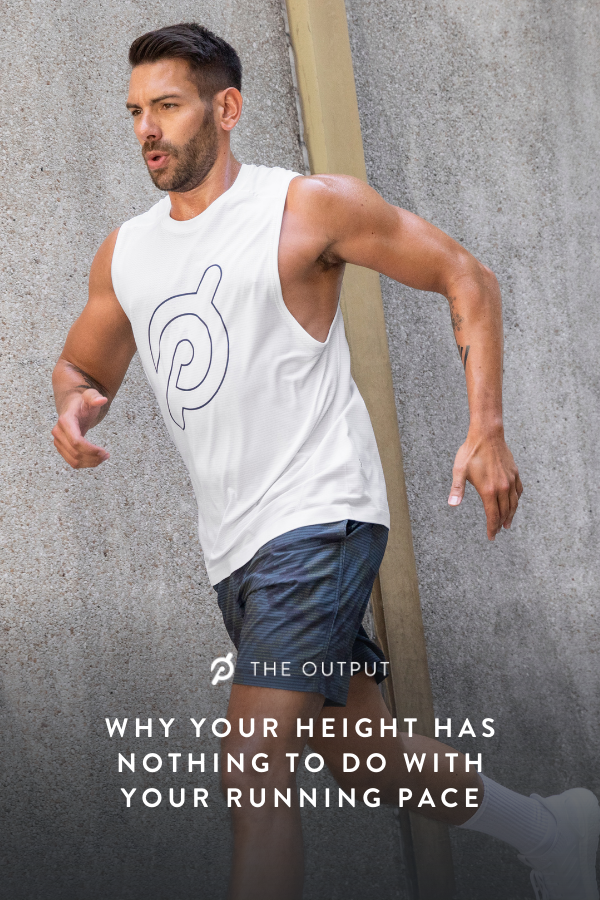
Why Your Height Has Nothing to Do With Your Running Pace
If you want to rev up your runs, focus on your cadence.
By Colleen Travers•
Does Stride Length Affect Running Speed?
What About Cadence and Running Speed?
What Other Factors Affect Running Speed?
When it comes to running, you may have heard that you’re doomed from the starting line because of your height. A lot of people assume that being taller makes you speedier—but that’s simply not true. We chatted with Peloton Tread instructor Matty Maggiacomo about the myth that taller people run faster and how you can become both a better and faster runner no matter your height.
The real secret to speed? It’s all in how you pound the ground. Let’s jump in.
If you’ve ever watched a marathon or any Olympic running event, you’ll notice that many of the world’s top competitors are rather short. This is because the world’s fastest runners aren’t defined by their height, over which they have no control. Instead, some studies have shown that speed is to do with the force of their foot strike—the power in which their foot hits the ground, along with the stride length and cadence. And, this is something that runners of all heights can work on to achieve their personal best.
Does Stride Length Affect Running Speed?
Stride length is the distance between each step—when your foot first hits the ground, pushes up, then hits the ground again. Due to their build, taller runners tend to have longer leg strides than shorter runners—which in the past, was thought to be the main factor in determining running speed.
Studies have shown, however, that the fastest runners are actually those who have the most power in their ground strikes, rather than the amount of time their foot is in the air. It’s this strike force that sets the speed, which in turn also powering the stride length and rate.
What About Cadence and Running Speed?

Your stride rate, or running cadence, is the number of steps taken during your run. If you’re taking a Peloton Tread class, you’ll often hear the instructor coach to cadence, foot turnover, or stride rate, explains Matty, all of which are the same thing. “We’ll often cue you to focus on ‘quick steps’ to help you get your feet underneath you—instead of trying to open up your stride length—and this will help you get to 180 steps per minute, which is what legendary running coach Jack Daniels [author of the Daniels’ Running Formula] recommends when it comes to running and speed.”

Peloton App
Access thousands of classes with no equipment needed.
You can also increase your cadence by doing hill sprints during runs. “I love sprinting up a hill and then lowering the incline and sprinting again on a flat road,” Matty says. “You will absolutely get faster and feel lighter.”
What Other Factors Affect Running Speed?
How you hit the ground running is all down to strength, training, consistency in working out, and a little bit of genetics and biology thrown into the mix.
Speed Starts With Training
“There are a lot more contributing factors to achieving a fast running speed than just your height,” Matty says. “Practice makes perfect, but so does focusing on your strength and flexibility, as well as being well-rounded in your training.”
That’s why it’s important to alternate runs with runner-specific strength training workouts, like classes from Peloton’s Strength for Runners collection, and take time to do proper Pre- and Post-Run stretches, available on the Peloton App. On rest days, something as simple as a 10-minute yoga flow will help your flexibility without overdoing it.
V02 Max is Vital to Speed and Performance
It goes without saying that your breathing plays a major role in your running. But there’s a little more to it than that. Your performance depends on the maximum amount of oxygen you can take in—known as V02 max, for an extended period of time. V02 max is a measure of your body’s ability to process and use oxygen during aerobic exercise. Studies have shown that V02 max is both down to genetics and training, so there will be some runners who naturally have a better V02 max than others. And, while you can’t change your genetics, you can boost your V02 max through training. Studies into HIIT—high intensity interval training— show that with consistent practice you can improve your V02 max, which in turn can boost your metabolism too. So by lacing up and taking the time to cross-train, you’ll notice not only your endurance getting stronger, but your speed zooming right along with it.
Speed Can Be Genetic
Every athlete has a different weight, muscle mass, bone density, and amount of body fat, and all of these unique factors play a part in your running performance. “Taller individuals burn more energy, but they also tend to have bigger muscles that can generate more power and store more fuel, while shorter individuals tend to be more efficient,” Matty says. “The key point though relates to training, and the more you train the more you can overcome your disadvantages.”
Your unique genetics have a further part to play in your body’s overall performance. Studies have shown that there are certain physiological factors that may limit endurance and cardiovascular exercise like running. Your V02 max like we’ve already mentioned, but also how you burn energy and your hydration levels can all have an impact on performance too.
Muscle Fibers Play a Role
When you run, a combination of genetic and biomechanical factors are hard at work in both your speed and endurance. Crucial to this are your skeletal muscle fibers—found in your calves, hamstrings, glutes, quads, and so on. The building blocks of your movement.
There are two types of muscle fibers that come into play for running; type 1 also known as slow-twitch and type 2, fast-twitch. We all have a mix of these types depending on our physiology and genetics, but there are some tell-tale signs that you may have more of one type of fiber than the other. If you have more type 1 fibers, this may mean you have a slower speed as these fibers contract more slowly—hence that “slow twitch”—but it may mean you’ll be able to run longer distances as these fibers sustain a steady supply of energy and oxygen aerobically.
Type 2 or fast-twitch fibers contract the fastest but are anaerobic, meaning they’re great for quicker bursts of running energy—ideal for shorter-distance running and sprinting. If you’re better at that fast sprint, it’s possible you have more type 2 fibers.
Although genetically you’re born with a combination of these types of fibers, they can be built up over time with consistent training. Longer distance runs for strengthening your type 1s, and HIIT interval workouts and sprint training to help build those type 2s over time.
Good Posture Can Boost Speed and Help Avoid Injury
From cycling to running, walking to sitting, practicing good posture is key to avoiding injury and repetitive strain and improving your form no matter what activity you’re doing. For running, keeping your core engaged, your gaze forward—not down as this puts strain on the back of your neck, shoulders, and chest open, with a slight lean forward from the waist will help keep your pace consistent and comfortable.
If you’re concerned about your running posture, you can also schedule time with a physiotherapist or even a running specialist store who can analyze your running form and help you make adjustments to improve performance.
Your Diet Can Fuel Your Pace
It’s a no-brainer that your general health and wellbeing will affect your running speed and key to this is your diet. Making sure you follow a healthy, balanced, nutritious diet with plenty of fruit and vegetables, lean proteins, healthy fats, and healthy carbohydrates will help fuel your body for success.
As you focus more on your general training, you might want to focus on a more running-specific diet, and if you’re training for a marathon or other races, you’ll likely follow a more carb-focused diet to support the energy-burning your body will need.
Always consult your healthcare professional or a registered dietician before making any big changes to your diet.
If you’re focused on getting faster, these Tread workouts will help you hit your goals. Download the Peloton App for even more training and exercises to help you beat your PB.

Related Articles

Beginners
The Complete Beginner’s Guide to Running — Plus, All the Good Things That Happen Once You Start Running Regularly

Run
Treadmill Workouts Might Be the Key to Leveling Up Your Running — Here’s How

Nutrition
What to Eat Before Running In the Morning, No Matter How Much Time You Have to Spare

Run
Running Cadence Is an Overlooked Metric. Here’s Why It Matters
This content is for informational and educational purposes only and does not constitute individualized advice. It is not intended to replace professional medical evaluation, diagnosis, or treatment. Seek the advice of your physician for questions you may have regarding your health or a medical condition. If you are having a medical emergency, call your physician or 911 immediately.
Level up your inbox.
Subscribe for a weekly dose of fitness, plus the latest promos, launches, and events.
By providing your email address, you agree to receive marketing communications from Peloton.
For more about how we use your information, see our Privacy Policy.






